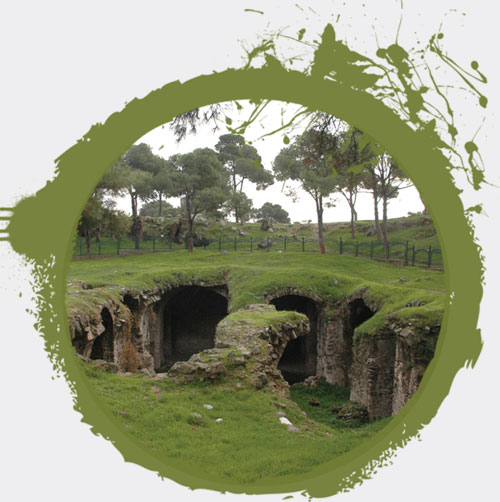
Kadifekale
The Persian rule in Anatolia started in 6th century BC when they defeated Lydian army and Captured Sardes and ended in 334 BC when Alexander the Great launched his campaign towards the East. Thus opens the Hellenistic Era bringing a new fashion of settlement in Eastern Mediterranean cities. The need for security and ease of trade resulted in cities located on foothills facing harbours. With this view, many cities were relocated and Smyrna is one of them.
Alexander the Great was hunting at the woods of Pagos hill when he fell asleep under a tree at the Nemesis holly area. In his dream he saw two Nemesis telling him to found a new city at this location. After waking up, Alexander refers his dream to Apollonian oracle priest who interpreted it in a single sentence: "Three and four times happy shall those men be hereafter, who shall dwell on Pagus beyond the sacred Meles."
Kadifekale, believed to have been built upon this oracle, is the acropolis and the grandiose fortress of the relocated İzmir during Hellenistic and Roman Period which could survive until today.
Finally, Lysimachos started the establishment of new Izmir when he killed his opponent, General Antiganos in 302 B.C. He started to build the city on Pagos Hill and shoulders with a view of Inland Port. Therefore, having been deterritorialized by the invasion of Lydians 400 years ago and lived in the area of Meles Brook in small villages, Smyrnians, the fellow townsmen of Homer, came and settled down in Izmir.
Kadifekale, was built by Lysimachos, a "successor" of Alexander the Great, providing protection to the city against foreign offensives. It went through several reconstructions and restoration works during Roman, Byzantine, Ottoman and Republican periods yet most of the surviving walls date back to middle Ages. Within the walls of the fortress, there are remains of cisterns and cellars from Byzantine Period. Although there were a stadium at its west side and an amphitheatre on the north, these buildings have disappeared over time as their building blocks were taken away to be used in constructions of other buildings.
Kadifekale rests on a 185 meters high hilltop overlooking the Bay and the settlements around. It was also known as "Upper Fortress". Kadifekale rested on a larger area originally than it does today. On its walls running along a perimeter of more than 6000 meters there were 24 bastions and towers, and its outer walls reached down to the sea. Kadifekale, that is to say the ancient city of Izmir had two main gates one of which is located at today’s Eşrefpaşa quarter and opened to the road to Ephesus and Kolophon, and the second located at today’s Basmane and opened to the road to Sardes. It was seriously damaged by the earthquakes in 178 and 1739. It also underwent a reconstruction by Byzantines in 395.
Beginning from 15th century, especially after the Archers’ Castle was built most of the people moved from Kadifekale to lower settlements on the shore, leaving the place almost completely desolated.
It is named, Evliya Çelebi suggests, after the legendary Quen Kaydafe the rival of Alexander the Great. As people began to resettle in Kadifekale after the Republic, stones from the old walls were taken to be used in constructions of new houses, consequently bringing some parts of Kadifekale to the brink of collapse. Even some public buildings, a primary school for instance, were built with stones from the ancient walls. In 1955 Izmir Municipality started an extensive renovation project and Kadifekale that has been under Turkish rule since 1317 obtained its modern day appearance.
Observing the walls west of the main gate, one would notice larger blocks of face stone on the base level than on the upper parts. These slightly curved stones dates from the Hellenistic period. The courtyard right inside the main gate is the west end of the acropolis. Along the walls one can also notice, along with Hellenistic and Roman built parts, bricks and the poor workmanship from the Middle age. The city walls, branching from those which surrounded the acropolis, reached down to the sea, also encompassing Today’s Basmane on the north and part of Demirdağ on the west.
In the writings of travellers visiting İzmir, an Amazon head figure is suggested to have existed on the wall next to the main gate. It must have been removed later, today its whereabouts is unknown.
The ruins that one would see on the left after entering the inner castle, are the remains of a mosque that was built by the Judge İlyas son of Ahmet in late 14th century. Some claim that this mosque was built on the ruins of Apocalyps Church that existed at the same spot. And others say it is the very spot at on which Nemesis Temple where Alexander the Great slept and had his dream, once stood.
The vaulted structures that lie in the hollows just across the gate belong to cisterns that were built by Romans and continued serving through Byzantine period. Apparently, water was brought to these cisterns through the aqueducts that can be seen in Şirinyer and from here distributed to the city via earthware pipes and canal systems.
Kadifekale is the best place to watch the stunning views of the beautiful İzmir and the Bay.